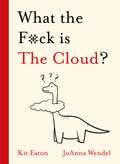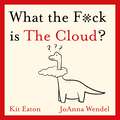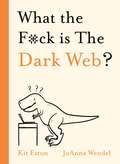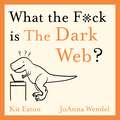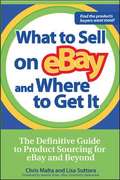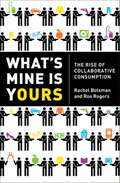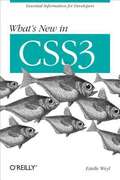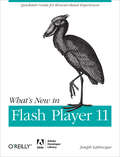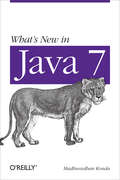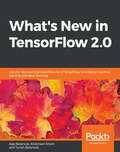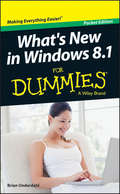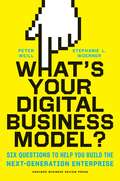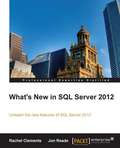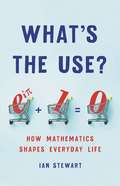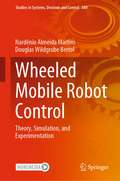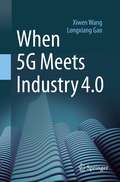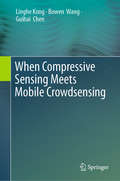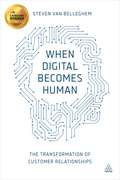- Table View
- List View
What the F*ck is The Cloud? (WTF Series)
by Kit EatonWhat the f*ck is the Cloud, and how does it even work?Ah, The Cloud. It's such a useful bit of tech jargon isn't it? The kind that's casually thrown around in work meetings by bosses who (kind of) understand and maybe even at the nerdier type of dinner or drinks parties. People joke about the cloud while others take it for granted and some worry about this mysterious entity where all of our data is stored, accessible at the touch of a screen from anywhere on Earth. But what even is the cloud, and for that matter, where is the cloud?Join us on a journey from the very first iterations of the internet that we know and (sometimes) love, all the way through thorny issues of data collection and storage (weren't we all fooled by the 'ten years on' social media trend, even as we rely on cloud-stored photos of cats to cheer us up?) and discover the mysterious place where The Cloud ominously hovers.
What the F*ck is The Cloud? (WTF Series)
by Kit EatonWhat the f*ck is the Cloud, and how does it even work?Ah, The Cloud. It's such a useful bit of tech jargon isn't it? The kind that's casually thrown around in work meetings by bosses who (kind of) understand and maybe even at the nerdier type of dinner or drinks parties. People joke about the cloud while others take it for granted and some worry about this mysterious entity where all of our data is stored, accessible at the touch of a screen from anywhere on Earth. But what even is the cloud, and for that matter, where is the cloud?Join us on a journey from the very first iterations of the internet that we know and (sometimes) love, all the way through thorny issues of data collection and storage (weren't we all fooled by the 'ten years on' social media trend, even as we rely on cloud-stored photos of cats to cheer us up?) and discover the mysterious place where The Cloud ominously hovers.
What the F*ck is The Cloud? (WTF Series)
by Kit EatonWhat the f*ck is the the Cloud and how does it work?Ah, The Cloud. It's such a useful bit of tech jargon isn't it? The kind that's casually thrown around in work meetings by bosses who (kind of) understand and maybe even at the nerdier type of dinner or drinks parties. People joke about the cloud while others take it for granted and some worry about this mysterious entity where all of our data is stored, accessible at the touch of a screen from anywhere on Earth. But what even is the cloud, and for that matter, where is the cloud?Join us on a journey from the very first iterations of the internet that we know and (sometimes) love, all the way through thorny issues of data collection and storage (weren't we all fooled by the 'ten years on' social media trend, even as we rely on cloud-stored photos of cats to cheer us up?) and discover the mysterious place where The Cloud ominously hovers.(P) 2021 Hodder & Stoughton Ltd
What the F*ck is The Dark Web? (WTF Series)
by Kit EatonWhat the f*ck is the Dark Web, and how does it even work?Whether it's from dodgy acronym-titled crime shows to news stories designed to terrify you down to your socks we've all heard about sites like Silk Road and the ways criminals use cryptocurrency online. But did you know that among the various shady corners of the dark web you can also find portals to the BBC and Facebook?The thing is even the way the everyday internet works is a mystery to us and its darkest corners are, of course, more deeply shrouded. So, let's go on a journey from the birth of the Net through the strangest dark services - need a hitman to bump off your superfluous...er...beloved spouse? - to the surprisingly positive uses of dark technology, including dodging the watchful eye of oppressive censors.Over half of us can't remember a time before the internet - and for the rest it's increasingly difficult to imagine life without the damn thing! It's about time we understood more about it and we can start with the question: What The Fuck is The Dark Web?
What the F*ck is The Dark Web? (WTF Series)
by Kit EatonWhat the f*ck is the Dark Web, and how does it even work?Whether it's from dodgy acronym-titled crime shows to news stories designed to terrify you down to your socks we've all heard about sites like Silk Road and the ways criminals use cryptocurrency online. But did you know that among the various shady corners of the dark web you can also find portals to the BBC and Facebook?The thing is even the way the everyday internet works is a mystery to us and its darkest corners are, of course, more deeply shrouded. So, let's go on a journey from the birth of the Net through the strangest dark services - need a hitman to bump off your superfluous...er...beloved spouse? - to the surprisingly positive uses of dark technology, including dodging the watchful eye of oppressive censors.Over half of us can't remember a time before the internet - and for the rest it's increasingly difficult to imagine life without the damn thing! It's about time we understood more about it and we can start with the question: What The Fuck is The Dark Web?
What the F*ck is The Dark Web? (WTF Series)
by Kit EatonWhat the f*ck is the dark web and how does it work?Whether it's from dodgy acronym-titled crime shows to news stories designed to terrify you down to your socks we've all heard about sites like Silk Road and the ways criminals use cryptocurrency online. But did you know that among the various shady corners of the dark web you can also find portals to the BBC and Facebook?The thing is even the way the everyday internet works is a mystery to us and its darkest corners are, of course, more deeply shrouded. So, let's go on a journey from the birth of the Net through the strangest dark services - need a hitman to bump off your superfluous...er...beloved spouse? - to the surprisingly positive uses of dark technology, including dodging the watchful eye of oppressive censors.Over half of us can't remember a time before the internet - and for the rest it's increasingly difficult to imagine life without the damn thing! It's about time we understood more about it and we can start with the question: What The Fuck is The Dark Web?
What to Miss When: Poems
by Leigh SteinPoems about pop culture, mortality, and the internet, written during the Coronavirus pandemic—for readers who are more likely to double-tap Instapoems than put their phone down long enough to read The Decameron.Catalyzed by sheltering in place and by a personal challenge to give up alcohol for thirty days, Leigh Stein, the poet laureate of The Bachelor, has written a twenty-first-century Decameron to frame modern fables. What to Miss When makes mischief of reality TV and wellness influencers, juicy thoughtcrimes and love languages, and the mixed messages of contemporary feminism. &“Think Starlight,&” the first poem in this collection, written before any self-quarantine orders, imagined the likelihood that the United States would follow in Italy&’s footsteps in terms of caseload and hospital overwhelm. By March 17, 2020, the imagined was the real: New York City had closed schools, bars, and restaurants—with the rest of the country close behind. With nihilist humor and controlled despair, What to Miss When explores fears of death and grocery shopping, stress cleaning and drinking, celebrities behaving badly, everything we took for granted, and life mediated by screens—with dissociation-via-internet, and looking for mirrors in a fourteenth-century pandemic text, a kind of survival response to living casually through catastrophe.
What to Sell on eBay and Where to Get It
by Chris Malta Lisa SuttoraLearn to generate product ideas, research your markets, diversify your product line, and build a direct supply of inventory. Using the proven strategies in this book, you'll be able to find the products that will fuel your business for the long term.
What to Think About Machines That Think: Today's Leading Thinkers on the Age of Machine Intelligence
by Mr John BrockmanAs the world becomes ever more dominated by technology, John Brockman’s latest addition to the acclaimed and bestselling “Edge Question Series” asks more than 175 leading scientists, philosophers, and artists: What do you think about machines that think? <P><P> The development of artificial intelligence has been a source of fascination and anxiety ever since Alan Turing formalized the concept in 1950. Today, Stephen Hawking believes that AI “could spell the end of the human race.” At the very least, its development raises complicated moral issues with powerful real-world implications—for us and for our machines. <P> In this volume, recording artist Brian Eno proposes that we’re already part of an AI: global civilization, or what TED curator Chris Anderson elsewhere calls the hive mind. And author Pamela McCorduck considers what drives us to pursue AI in the first place. <P> On the existential threat posed by superintelligent machines, Steven Pinker questions the likelihood of a robot uprising. Douglas Coupland traces discomfort with human-programmed AI to deeper fears about what constitutes “humanness.” Martin Rees predicts the end of organic thinking, while Daniel C. Dennett explains why he believes the Singularity might be an urban legend.
What's Fair on the Air?: Cold War Right-Wing Broadcasting and the Public Interest
by Heather HendershotThe rise of right-wing broadcasting during the Cold War has been mostly forgotten today. But in the 1950s and ’60s you could turn on your radio any time of the day and listen to diatribes against communism, civil rights, the United Nations, fluoridation, federal income tax, Social Security, or JFK, as well as hosannas praising Barry Goldwater and Jesus Christ. Half a century before the rise of Rush Limbaugh and Glenn Beck, these broadcasters bucked the FCC’s public interest mandate and created an alternate universe of right-wing political coverage, anticommunist sermons, and pro-business bluster. A lively look back at this formative era, What’s Fair on the Air? charts the rise and fall of four of the most prominent right-wing broadcasters: H. L. Hunt, Dan Smoot, Carl McIntire, and Billy James Hargis. By the 1970s, all four had been hamstrung by the Internal Revenue Service, the FCC’s Fairness Doctrine, and the rise of a more effective conservative movement. But before losing their battle for the airwaves, Heather Hendershot reveals, they purveyed ideological notions that would eventually triumph, creating a potent brew of religion, politics, and dedication to free-market economics that paved the way for the rise of Ronald Reagan, the Moral Majority, Fox News, and the Tea Party.
What's Mine Is Yours: The Rise of Collaborative Consumption
by Roo Rogers Rachel Botsman“Amidst a thousand tirades against the excesses and waste of consumer society, [this book] offers us something genuinely new and invigorating: a way out.” —Steven Johnson, New York Times–bestselling author of The Infernal MachineA groundbreaking and original book, What’s Mine is Yours articulates for the first time the roots of “collaborative consumption,” the authors’ term for the technology-based peer communities that are transforming the traditional landscape of business, consumerism, and the way we live. Those who seek an alternative to voracious shopping and the mindless accumulation of possessions will be inspired by this landmark contribution to the evolving ecology of commerce and sustainability.“Driven by growing dissatisfaction with their role as robotic consumers manipulated by marketing, people are turning more and more to models of consumption that emphasize usefulness over ownership, community over selfishness, and sustainability over novelty . . . Part cultural critique and part practical guide to the fledgling collaborative consumption market, the book provides a wealth of information for consumers looking to redefine their relationships with both the things they use and the communities they live in.” —Publishers Weekly
What's New in Adobe AIR 3
by Joseph LabrecqueThis book will present you with a full rundown of all the new features in the upcoming AIR 3.0 runtime. Along with each feature, if applicable, will be a demonstration of how to employ the new feature. There's also be a short introduction to AIR and a chapter dedicated to providing you with additional resources.
What's New in CSS3
by Estelle WeylCascading Style Sheets (CSS) began as a clean way to separate formatting from content, but it has grown into a powerful toolkit for layout and interface design. CSS Level 3, commonly called CSS3, divides its work up into modules, many of which are available for you to use today. What's New in CSS3 provides a brief overview of the many parts of CSS3 whether they are Recommendations, Working Drafts, or pieces left aside. Transformations and Animations may be highly visible parts of new interface styles, but new selectors and layout approaches will also change the way you work. If you've been wondering which parts of the CSS3 conversation are for you, What's New in CSS3 will get you started.
What's New in Flash Player 11
by Joseph LabrecqueThis book will present you with a full rundown of all the new features in the upcoming Flash Player 11 runtime. Along with each feature, if applicable, will be a demonstration of how to employ the new feature. There's also be a short introduction to Flash Player and a chapter dedicated to providing you with additional resources.
What's New in Java 7
by Madhusudhan KondaJava 7 has a number of features that will please developers. Madhusudhan Konda provides an overview of these, including strings in switch statements, multi-catch exception handling, try-with-resource statements, the new File System API, extensions of the JVM, support for dynamically-typed languages, and the fork and join framework for task parallelism.
What's New in TensorFlow 2.0: Use the new and improved features of TensorFlow to enhance machine learning and deep learning
by Ajay Baranwal Alizishaan Khatri Tanish BaranwalGet to grips with key structural changes in TensorFlow 2.0 Key Features Explore TF Keras APIs and strategies to run GPUs, TPUs, and compatible APIs across the TensorFlow ecosystem Learn and implement best practices for building data ingestion pipelines using TF 2.0 APIs Migrate your existing code from TensorFlow 1.x to TensorFlow 2.0 seamlessly Book Description TensorFlow is an end-to-end machine learning platform for experts as well as beginners, and its new version, TensorFlow 2.0 (TF 2.0), improves its simplicity and ease of use. This book will help you understand and utilize the latest TensorFlow features. What's New in TensorFlow 2.0 starts by focusing on advanced concepts such as the new TensorFlow Keras APIs, eager execution, and efficient distribution strategies that help you to run your machine learning models on multiple GPUs and TPUs. The book then takes you through the process of building data ingestion and training pipelines, and it provides recommendations and best practices for feeding data to models created using the new tf.keras API. You'll explore the process of building an inference pipeline using TF Serving and other multi-platform deployments before moving on to explore the newly released AIY, which is essentially do-it-yourself AI. This book delves into the core APIs to help you build unified convolutional and recurrent layers and use TensorBoard to visualize deep learning models using what-if analysis. By the end of the book, you'll have learned about compatibility between TF 2.0 and TF 1.x and be able to migrate to TF 2.0 smoothly. What you will learn Implement tf.keras APIs in TF 2.0 to build, train, and deploy production-grade models Build models with Keras integration and eager execution Explore distribution strategies to run models on GPUs and TPUs Perform what-if analysis with TensorBoard across a variety of models Discover Vision Kit, Voice Kit, and the Edge TPU for model deployments Build complex input data pipelines for ingesting large training datasets Who this book is for If you're a data scientist, machine learning practitioner, deep learning researcher, or AI enthusiast who wants to migrate code to TensorFlow 2.0 and explore the latest features of TensorFlow 2.0, this book is for you. Prior experience with TensorFlow and Python programming is necessary to understand the concepts covered in the book.
What's New in Windows 8.1 For Dummies
by Brian UnderdahlWhat's New in Windows 8.1 For Dummies Pocket Edition provides a brief, inexpensive, and focused guide for Windows 8 users upgrading to 8.1. Chapters include:It's all about you: An exploration of the customization features, from flexible sizing on icons to shared wallpaper to boot options.We can build it better: Review of the updates to applications with special emphaisis on communications and media appsShiny new toys: Walkthroughs of the new features added to Windows 8.1, including the start button and search functionTen reasons you were smart to upgrade: In the spirit of the For Dummies Part of Tensfeature, a list of the reasons why Windows 8.1 is a superior experience to Windows 8.
What's Your Digital Business Model?: Six Questions to Help You Build the Next-Generation Enterprise
by Peter Weill Stephanie Woerner<p>What is your digital business model? While many leaders of companies recognize the threat from digital--and the potential opportunity--they lack a common language or a compelling framework to help them assess it and, more importantly, to direct them. They don't know how to think about their digital business model. In this probing and practical book, Peter Weill and Stephanie Woerner provide much-needed tools, self-assessments, motivating examples, and key financial analyses of where the profits will likely be made. <p>Based on five years of study at the MIT Center for Information Systems Research, the book provides a powerful yet simple framework that has been field-tested globally with more than a dozen senior management teams. The authors found that digitization is moving companies' business models on two dimensions: from value chains to digital ecosystems, and from a fuzzy understanding of the needs of end customers to a sharper one. Looking at these dimensions in combination results in four distinct business models, each with different capabilities: (1) Supplier, (2) Omni-channel, (3) Modular Producer, and (4) Ecosystem Driver. The framework helps companies clarify where they are currently in an increasingly digital business landscape and highlights what's needed to move toward another, higher-value digital business model. <p>In meeting the growing challenge to "go digital," this smart book will help you grapple with the threats, respond to the opportunities, and create winning digital strategies.</p>
What's new in SQL Server 2012
by Rachel Clements Jon ReadeThis is a hands-on book to quickly get you up to speed with SQL Server 2012. It covers all the new features of the core database engine as well as the business intelligence (BI) services.The book begins by taking you step-by-step through the installation process, showing you what to install and which services and features you need. Once you have your SQL Server in place, you learn how to administer it and then explore new T-SQL functions to expand your query-writing toolkit. You will discover how the enhancements to Integration Services, Analysis Services and Reporting Services make developing BI solutions easier. It will then introduce you to SQL Server Data Tools, your new and improved development environment for creating database and BI projects.A hands-on example guides you through the steps required to run Distributed Replay, giving you the experience you need to apply this in the field. The book then takes you through a detailed example to show you how to create a Data Quality Services project and cleanse real-world data. Easy to follow code samples provide you with the queries you need to set up Availability Groups using the new AlwaysOn technology.Once you are comfortable with these new features you will be ready to migrate your data to the cloud and into SQL Azure. An exploration of Hadoop will help you understand big data and how it really is the next big thing,This concise reference is for database administrators, SQL Server Developers and BI professionals. Anyone who is familiar with SQL Server 2008 R2 and needs to make the jump to the latest version with the shortest learning curve will find this book useful.
What's the Use?: How Mathematics Shapes Everyday Life
by Ian StewartSee the world in a completely new way as an esteemed mathematician shows how math powers the world—from technology to health care and beyond. Almost all of us have sat in a math class, wondering when we'd ever need to know how to find the roots of a polynomial or graph imaginary numbers. And in one sense, we were right: if we needed to, we'd use a computer. But as Ian Stewart argues in What's the Use?, math isn't just about boring computations. Rather, it offers us new and profound insights into our world, allowing us to accomplish feats as significant as space exploration and organ donation. From the trigonometry that keeps a satellite in orbit to the prime numbers used by the world's most advanced security systems to the imaginary numbers that enable augmented reality, math isn't just relevant to our lives. It is the very fabric of our existence.
Wheeled Mobile Robot Control: Theory, Simulation, and Experimentation (Studies in Systems, Decision and Control #380)
by Nardênio Almeida Martins Douglas Wildgrube BertolThis book focuses on the development and methodologies of trajectory control of differential-drive wheeled nonholonomic mobile robots. The methodologies are based on kinematic models (posture and configuration) and dynamic models, both subject to uncertainties and/or disturbances. The control designs are developed in rectangular coordinates obtained from the first-order sliding mode control in combination with the use of soft computing techniques, such as fuzzy logic and artificial neural networks. Control laws, as well as online learning and adaptation laws, are obtained using the stability analysis for both the developed kinematic and dynamic controllers, based on Lyapunov’s stability theory. An extension to the formation control with multiple differential-drive wheeled nonholonomic mobile robots in trajectory tracking tasks is also provided. Results of simulations and experiments are presented to verify the effectiveness of the proposed control strategies for trajectory tracking situations, considering the parameters of an industrial and a research differential-drive wheeled nonholonomic mobile robot, the PowerBot. Supplementary materials such as source codes and scripts for simulation and visualization of results are made available with the book.
When 5G Meets Industry 4.0
by Longxiang Gao Xiwen WangSince the 1980s, mobile communication has undergone major transitions from 1G to 4G, at a rate of roughly one generation per decade. And the next upgrade is set to come soon, with 5G heralding a new era of large-bandwidth Internet, and a multi-connection, low-latency Internet of Everything.5G technology will be the standard for next-generation mobile Internet, and it will not only enhance the individual user’s experience, but also provide technical support for artificial-intelligence-based applications, such as smart manufacturing, smart healthcare, smart government, smart cities and driverless cars. As a result, 5G is regarded as the “infrastructure” of the industrial Internet and artificial intelligence and both China and the United States are striving to become the 5G leader and spearhead this new generation of international mobile communication standards. Though trade tensions between China and the United States continue to escalate, with products ranging from soybeans to mobile phones and automobiles being affected, 5G technology may be the true cause of trade wars between the world’s top two economies.In short, 5G will change not only society, but also international trade patterns. This book describes various 5G scenarios, changes and values; explains the standards, technologies and development directions behind 5G; and explores new models, new formats and new trends in 5G-based artificial intelligence.
When Compressive Sensing Meets Mobile Crowdsensing
by Guihai Chen Linghe Kong Bowen WangThis book provides a comprehensive introduction to applying compressive sensing to improve data quality in the context of mobile crowdsensing. It addresses the following main topics: recovering missing data, efficiently collecting data, preserving user privacy, and detecting false data.Mobile crowdsensing, as an emerging sensing paradigm, enables the masses to take part in data collection tasks with the aid of powerful mobile devices. However, mobile crowdsensing platforms have yet to be widely adopted in practice, the major concern being the quality of the data collected. There are numerous causes: some locations may generate redundant data, while others may not be covered at all, since the participants are rarely systematically coordinated; privacy is a concern for some people, who don’t wish to share their real-time locations, and therefore some key information may be missing; further, some participants may upload fake data in order to fraudulently gain rewards. To address these problematic aspects, compressive sensing, which works by accurately recovering a sparse signal using very few samples, has proven to offer an effective solution.
When Computers Were Human
by David Alan GrierBefore Palm Pilots and iPods, PCs and laptops, the term "computer" referred to the people who did scientific calculations by hand. These workers were neither calculating geniuses nor idiot savants but knowledgeable people who, in other circumstances, might have become scientists in their own right. When Computers Were Human represents the first in-depth account of this little-known, 200-year epoch in the history of science and technology. Beginning with the story of his own grandmother, who was trained as a human computer, David Alan Grier provides a poignant introduction to the wider world of women and men who did the hard computational labor of science. His grandmother's casual remark, "I wish I'd used my calculus," hinted at a career deferred and an education forgotten, a secret life unappreciated; like many highly educated women of her generation, she studied to become a human computer because nothing else would offer her a place in the scientific world. The book begins with the return of Halley's comet in 1758 and the effort of three French astronomers to compute its orbit. It ends four cycles later, with a UNIVAC electronic computer projecting the 1986 orbit. In between, Grier tells us about the surveyors of the French Revolution, describes the calculating machines of Charles Babbage, and guides the reader through the Great Depression to marvel at the giant computing room of the Works Progress Administration. When Computers Were Human is the sad but lyrical story of workers who gladly did the hard labor of research calculation in the hope that they might be part of the scientific community. In the end, they were rewarded by a new electronic machine that took the place and the name of those who were, once, the computers.
When Digital Becomes Human
by Steven Van BelleghemIn an age when customers have access to vast amounts of data about a company, its product and its competitors, customer experience becomes increasingly important as a sustainable source of competitive advantage. But success doesn't just rely on digital engagement and excellence, but also on combining a digital-first attitude with a human touch. In When Digital Becomes Human, Steven Van Belleghem explores and explains the new digital relationships. Packed with global examples from organizations that have successfully transformed their customer relationships, such as Amazon, Toyota, ING, Coolblue, Nike and Starbucks, When Digital Becomes Human presents a clear model that companies can easily implement to integrate an emotional layer into their digital strategy. This guide to combining two of a business's most important assets - its people and its digital strengths - covers the latest issues in digital marketing and customer experience management, including omnichannel and multichannel experiences, big data and predictive analytics, privacy concerns, customer collaboration (ie crowdsourcing) and more.
